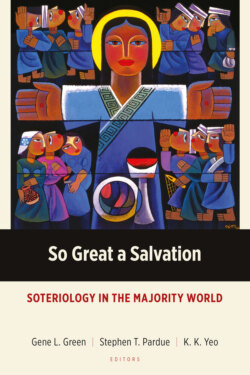Читать книгу So Great a Salvation - Группа авторов - Страница 23
На сайте Литреса книга снята с продажи.
The Spirit’s Application: Sanctification and Glorification
ОглавлениеTrends concerning sanctification involve regeneration, spirituality, and glorification, or theosis. For some, regeneration is the initial event of being made new by the Spirit, either logically preceding faith (as for most Calvinists and those affirming baptismal regeneration) or proceeding from it (as for most Arminians). For others, “regeneration” is a virtual synonym of “sanctification,” denoting a process of renewal rather than initial reception of a new nature. Apart from interest in conversion as more process- and less event-oriented, few current trends affect regeneration as such.[23] In some circles, though, the positional aspect of sanctification—associated with justification as an initial event—is gaining renewed emphasis. “Sanctification” terminology in the Bible usually addresses being set apart positionally as God’s people, a status that contains a continual calling toward holiness—yet not itself a process involving human initiative. When (instead) that process of sanctification (in more systematic-theological terms) is in view, the biblical-theological terminology focuses on being renewed, being transformed, growing in grace. From this perspective sanctification needs more emphasis on divine initiative than many views of the Christian life provide.[24]
Spirituality has certainly received contemporary theological attention. Classic theologians’ spiritual priorities are being recovered, with particular attention to Christian virtues and practices.[25] Interest in spirituality without religion has elicited theological pursuit of authentic Christian responses to that cultural trend. Protestant openness to theosis, with attention to the contemplative end of our earthly pilgrimage, stems partly from trends in Pauline studies and connections with other New Testament corpora.[26] Perhaps it also stems from neglected aspects of Christ’s work—broadening atonement beyond the cross to consider implications of his incarnation, earthly ministry, burial, resurrection, and ascension. Even on traditional Pauline terms, Western soteriologies need better accounts of Romans 4:25 (“He was delivered over to death for our sins and was raised to life for our justification”), especially in light of the encompassing Trinitarian vision of Romans 8.
Speaking of theosis, and/or glorification, completes our overview of the ordo salutis. Orthodox and Catholic accounts of salvation’s final end have remained relatively stable, with the Orthodox rarely pursuing a technical ordo and the Catholic one being largely sacramental in nature. Yet their classic underpinnings challenge contemporary Protestants who have become more aware of patristic Christology. If early arguments for the Son’s full divinity tie salvation tightly to the incarnation—God taking on humanity in Christ so that believers might take on the divine nature in him—then salvation cannot solely consist in an atoning transaction accomplished by a human sacrifice (however flawless) on the cross. Such transactional myopia is actually not the classic Protestant view, but popular aberrations need correction: if Christ’s full divinity is soteriologically essential, then evangelical theologies must more fully integrate incarnation and atonement, correspondingly relating salvation’s end to the fullness of bearing the divine image.
As theosis rises in Protestant prominence, however, the communal embrace of humanity in the incarnation and the cosmic reach of its implications have elicited critique of limited notions of glorification. Sometimes it seems as if spiritual life and divine likeness do not involve the social, earthly dimensions of created humanity but instead transcend those tempting obstacles. Few theologies say as much, but many in Western traditions live as such. Again, popular aberrations need correction: theosis, the beatific vision, or glorification—by whatever name—is not individualistic, disembodied, passive, eternal gazing on the divine essence after the present universe has been annihilated. Against such assumptions based on texts like 2 Peter 3, there has been increasing biblical-theological emphasis on new creation and historical-theological emphasis on resurrection. In light of Christ’s incarnation and his resurrection as the first fruits of ours, true Christian teaching resists an unhealthy dualism between the material and the spiritual.[27] Rather than escaping from the body, community, and the cosmos, Christians wait in hope for God to make all things new. Yet such an emphasis introduces further critique of Western soteriological blind spots.
